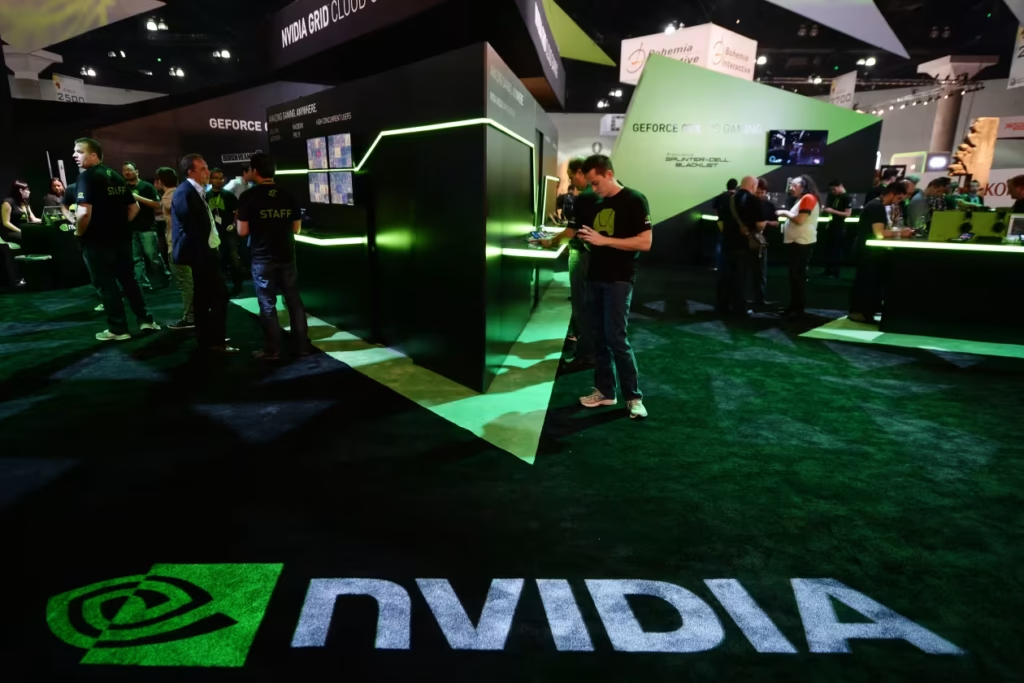
Nvidia’s Stock Declines as the AI Boom Slows and Rivals Heat Up The
Early Tuesday, investor fears over slowing AI spending and growing competition in the semiconductor market caused Nvidia (NVDA), the leading AI chipmaker, to see a more than 2% decline in its stock price. A rare setback for one of 2024’s most talked-about stocks is evident as shares are currently down 14% from its record high closing price of $148.88 in early November.
From Gaming to AI King: The Ascent and Current Issues of Nvidia
The path of Nvidia has been nothing short of remarkable. Nvidia, a pioneer in gaming graphics cards, rose to prominence as the market for AI chips exploded. For training large AI models, like OpenAI’s GPT series, its GPUs (graphics processing units) have emerged as the industry standard. Tech Powerhouse momentarily overtook Apple (AAPL) as the most valuable business in the world in 2024. It also replaced Intel (INTC) as a member of the esteemed Dow Jones Industrial Average (DJI).
Despite this quick ascent, problems are starting to surface.
Why is the stock of The AI Chip Leader declining?
1. Slower development in AI Spending: Following months of rapidly increasing AI investments, big firms like Google (GOOG) and Microsoft (MSFT) indicated intentions to slow the development of their AI spending. Although investment on AI infrastructure increased by 57% in 2024, researchers predict that growth would drop to 25% in 2026 and 30% in 2025.
Although it represents a slowdown following an early flurry, this is hardly the end of AI investment.
2. Blackwell Chip Challenges: There have been reports of overheating problems with Nvidia’s much awaited Blackwell AI processors, which are essential to the company’s future expansion. TF International Securities analyst Ming-Chi Kuo pointed up issues with power chips being tested for Nvidia’s GB300 and B300 systems. These problems raise investor apprehension even though they might not stop manufacturing.
3. Increasing Competition: Rivals are taking action.
a) With plans to power extensive AI infrastructure, Amazon (AMZN) is creating its own AI processors, called Trainium.
b) By negotiating huge contracts with hyperscalers valued at up to $90 billion over the next three years, Broadcom (AVGO) is making headway with custom XPUs.
c) Advanced Micro Devices (AMD) and Marvell Technology (MRVL) are also eroding The AI Chip Leader’s market share.
4. China Antitrust Probe: China’s competition watchdog revealed this week that it is looking into Nvidia’s $7 billion purchase of networking technology startup Mellanox for antitrust violations. This makes Nvidia’s prospects more uncertain in terms of regulations.
Stock in the Correctional Area
The AI Chip Leader’s stock dropped more than 10% from its peak on Monday, marking the company’s official entry into correction territory. Nvidia’s stock was down 1.6% at $129.85 by Tuesday noon. In general, the semiconductor industry fell, with Marvell Technology losing 9.4% and Broadcom decreasing 5.4%.
Even thoughTech Powerhouseis still a darling on Wall Street, its performance has stagnated in the last month as investors wait for details regarding the Blackwell series’ production schedule and sales results.
The Big Picture: Significant Investment in AI Remains
Even with temporary challenges, tech companies continue to place a high premium on AI infrastructure. Microsoft almost increased its capital spending to $20 billion in the most recent quarters.
• Meta (META) revealed that its spending had increased by 36% to $9.2 billion.
• Google spent $13 billion, a 63% increase.
But when businesses keep spending billions on AI with no discernible, quick returns, mistrust looms. Only 4% of US workers use AI on a daily basis, according to a Gallup poll that Bloomberg quoted, raising concerns about when these enormous expenditures will be profitable.
Comparing Nvidia vs Broadcom: Differing Routes
Broadcom has been booming while Nvidia is managing investor prudence.
Why In the last five days, Broadcom shares have increased 40% as a result of positive projections and better-than-expected profits.
• Hock Tan, the CEO of Broadcom, emphasized the “massive” potential for custom AI chips, with hyperscalers spearheading the effort to create their own accelerators.
The success of Broadcom won’t come at the expense of Nvidia, according to analysts like Goldman Sachs, who continue to have bullish price forecasts for the company.
What Will Happen to Nvidia Next?
Nvidia’s development narrative is far from done, despite its recent setbacks:
• Technical issues like overheating are unlikely to hurt long-term sales if they are promptly resolved; • Nvidia continues to hold its position as the top supplier of AI chips, an area with enormous growth potential;
• The demand for its Blackwell AI chips is still enormous, with orders scheduled well into 2025.
Following Nvidia’s 160% stock increase this year, investors may be taking profits for the time being and turning to rivals like Broadcom for quick gains.
Concluding remarks
Rather than a serious flaw in the company’s AI division, Nvidia’s recent decline is a reflection of larger market trends and escalating competition. Even though the increase of AI spending may decrease, Nvidia is currently leading the tough competition to control AI infrastructure.
Nvidia’s long-term prospects are still bright as the AI revolution unfolds, but recent volatility underscores the intensifying competition and investor apprehension in the rapidly changing AI field.